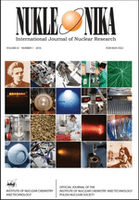
NUKLEONIKA
Scope & Guideline
Leading the Charge in Open Access Scientific Inquiry
Introduction
Aims and Scopes
- Nuclear Physics and Radiation Applications:
The journal covers research in nuclear physics, including studies on radiation interactions, detection methods, and dosimetry, highlighting innovations in radiation applications for both industrial and medical purposes. - Environmental and Health Impact Studies:
Research addressing the environmental implications of nuclear technology, including the assessment of radiation exposure and contamination effects on health, particularly in relation to specific populations or geographical regions. - Material Science in Nuclear Applications:
Focus on the development and characterization of materials utilized in nuclear applications, such as cladding materials, dosimeters, and radiation shielding, emphasizing their performance under radiation exposure. - Nuclear Reactor Design and Optimization:
Studies related to the optimization of reactor designs and operational parameters, including the use of advanced computational methods and genetic algorithms to enhance efficiency and safety in nuclear power generation. - Innovative Radiation Treatment Techniques:
Exploration of new methodologies for radiation treatment, including electron beam technology and gamma irradiation applications in waste management, pollution reduction, and biomedical fields.
Trending and Emerging
- Health Physics and Radiological Safety:
An increasing emphasis on health physics and radiological safety, particularly studies assessing the impact of radiation on human health, reflects a growing concern for public safety and regulatory compliance in nuclear applications. - Electron Beam Technology:
The trend towards the utilization of electron beam technology in various applications, such as wastewater treatment and material modification, is gaining momentum, showcasing its versatility and efficacy in environmental and industrial processes. - Advanced Dosimetry Techniques:
There is a notable rise in research concerning advanced dosimetry techniques, particularly for low-dose applications, indicating a demand for precise measurement methods in medical and environmental contexts. - Nanotechnology in Nuclear Applications:
Emerging studies exploring the intersection of nanotechnology and nuclear science suggest a growing interest in the development of nanomaterials for radiation detection, drug delivery, and enhanced imaging techniques. - Sustainable Practices in Nuclear Technology:
A shift toward sustainable practices within nuclear technology, including the use of renewable resources and environmentally-friendly materials in nuclear applications, highlights the journal's response to global sustainability challenges.
Declining or Waning
- Traditional Radioactive Waste Management:
Research focused on conventional methods of radioactive waste management has decreased, possibly due to the emergence of more advanced treatment technologies and a shift towards sustainability in waste handling. - Basic Radiation Detection Techniques:
There has been a decline in publications centered on basic radiation detection techniques, likely as researchers move towards more sophisticated, innovative detection systems that incorporate advanced materials and methodologies. - Geological and Mining Studies of Radioactive Materials:
Studies specifically focused on the geological aspects of radioactive material extraction and characterization are less frequent, indicating a potential shift towards applied research in nuclear technology and safety rather than exploratory geological studies. - Low-Temperature Plasma Studies:
Research on low-temperature plasma applications has waned, suggesting that the focus has shifted towards more practical applications of plasma technology in higher temperature regimes or alternative areas of nuclear science. - Theoretical Models of Radiation Effects:
Theoretical studies on radiation effects that do not translate into practical applications have seen a decline, as the journal appears to favor empirical research with direct implications for technology and safety.
Similar Journals

NUCLEAR INSTRUMENTS & METHODS IN PHYSICS RESEARCH SECTION B-BEAM INTERACTIONS WITH MATERIALS AND ATOMS
Advancing Knowledge in Nuclear Physics and InstrumentationNUCLEAR INSTRUMENTS & METHODS IN PHYSICS RESEARCH SECTION B-BEAM INTERACTIONS WITH MATERIALS AND ATOMS, published by Elsevier, is a pivotal journal in the fields of nuclear and high energy physics as well as instrumentation. With an ISSN of 0168-583X and an E-ISSN of 1872-9584, this journal has been a significant contributor to the scientific community since its inception in 1983. Covering an extensive range of topics related to beam interactions with various materials and atoms, the journal serves as an essential resource for researchers, professionals, and students alike. It holds a respectable Q3 category ranking in both instrumentation and nuclear high energy physics as of 2023, indicating its relevance and quality within these domains. While the journal currently does not offer open access options, its invaluable findings are accessible through numerous academic libraries and institutions. With the publication's emphasis on fostering advancements in experimental techniques, instrumentation developments, and theoretical insights, it undoubtedly plays a crucial role in the ongoing progress and innovation in the field.
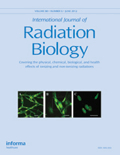
INTERNATIONAL JOURNAL OF RADIATION BIOLOGY
Innovating Insights in Nuclear MedicineINTERNATIONAL JOURNAL OF RADIATION BIOLOGY, published by Taylor & Francis Ltd, has established itself as a premier forum for the dissemination of innovative research related to radiation biology, covering emerging topics that are crucial within the fields of radiology, nuclear medicine, and ultrasound technology. With an ISSN of 0955-3002 and an E-ISSN of 1362-3095, this journal spans over six decades, from its inception in 1959 to 2024, reflecting a rich history of scholarly contribution and a dynamic approach to addressing current challenges in the discipline. Its reputation is highlighted by its Q2 rankings in both Radiology, Nuclear Medicine and Imaging and Radiological and Ultrasound Technology for 2023, underscoring its relevance in a competitive academic landscape, with Scopus rankings placing it in the top tier of its category. While operating under a traditional access model, the journal aims to connect researchers, professionals, and students, facilitating the advancement of knowledge and fostering a deeper understanding of the impact of radiation in various medical applications. The journal plays an essential role in shaping future research directions and enhancing clinical practices globally.
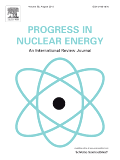
Progress in Nuclear Energy
Exploring innovations in nuclear technology and safety.Progress in Nuclear Energy is a premier academic journal published by Pergamon-Elsevier Science Ltd, dedicated to advancing the field of nuclear energy and its applications. With an ISSN of 0149-1970 and an E-ISSN of 1878-4224, this journal has made significant contributions to the scholarly community since its inception in 1977. The journal is recognized for its rigorous peer-reviewed research and has achieved impressive standings in multiple categories, including being ranked Q1 in Nuclear Energy and Engineering and Safety, Risk, Reliability and Quality for 2023. Its impact factor highlights the relevance and influence of the published work within the field. Researchers, professionals, and students seeking a comprehensive overview of current developments will find valuable insights in its pages. Covering a broad time span of publishing years, from 1977 through 2024, Progress in Nuclear Energy remains an essential resource for those involved in the energy sector, particularly in designing sustainable and safe nuclear technologies.

JOURNAL OF SYNCHROTRON RADIATION
Illuminating the Path of Open Access ResearchJOURNAL OF SYNCHROTRON RADIATION, an esteemed publication by the International Union of Crystallography, is a leading journal in the fields of Instrumentation, Nuclear and High Energy Physics, and Radiation. With an impressive impact factor and categorized as a Q1 journal across multiple disciplines in 2023, it demonstrates a commitment to advancing knowledge and applications in synchrotron radiation science. The journal has embraced an Open Access model since 2022, providing unrestricted access to cutting-edge research for a global audience. Published bi-monthly, JOURNAL OF SYNCHROTRON RADIATION serves as a vital platform for researchers, professionals, and students seeking to engage with the latest findings, methodologies, and innovations in synchrotron techniques and technologies. With its rich history from 1996 to 2024, it is recognized as a key resource for those aiming to push the boundaries of material science, structural biology, and beyond.
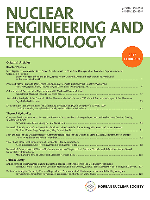
Nuclear Engineering and Technology
Exploring New Frontiers in Nuclear ScienceNuclear Engineering and Technology, published by the Korean Nuclear Society, is a premier Open Access journal dedicated to the rapidly evolving fields of nuclear energy and engineering. Established as a significant platform for scholarly communication since 2008, this journal has consistently anchored itself in the academic community, achieving a Q2 ranking in its category as of 2023, reflecting its influence and quality within the domain of Nuclear Energy and Engineering. With an impressive Scopus ranking of #15 out of 77, positioning it in the 81st percentile, the journal publishes cutting-edge research that addresses both fundamental and applied aspects of nuclear technology. Nuclear Engineering and Technology embraces an open access model since 2013, ensuring that valuable research is accessible to a global audience, thereby enhancing collaboration among researchers, professionals, and students passionate about advancing nuclear technology. The journal serves as an essential resource for those aiming to innovate and push the boundaries of knowledge in nuclear sciences.
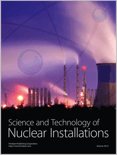
Science and Technology of Nuclear Installations
Catalyzing Knowledge in Nuclear Energy AdvancementsScience and Technology of Nuclear Installations, published by HINDAWI LTD, is an esteemed scholarly journal specializing in the dynamic field of nuclear energy and engineering, with an ISSN of 1687-6075 and an E-ISSN of 1687-6083. Since transitioning to an Open Access model in 2007, the journal has significantly contributed to the dissemination of innovative research and practical applications in nuclear technology, attracting a global audience from both academia and industry. Based in Egypt, this prominent journal serves as a vital platform for researchers seeking to explore advanced methodologies, cutting-edge technologies, and the sustainable development of nuclear installations. Achieving a commendable Q2 category ranking in Nuclear Energy and Engineering and positioning at #35/77 in Scopus rankings (55th percentile) underscores its influential presence within the scientific community. With a publication horizon extending from 2008 to 2024, the journal remains committed to fostering collaboration and innovation in nuclear science, making it an invaluable resource for researchers, professionals, and students alike.
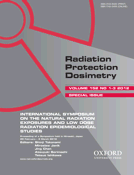
RADIATION PROTECTION DOSIMETRY
Empowering professionals through cutting-edge dosimetry insights.RADIATION PROTECTION DOSIMETRY is a vital academic journal dedicated to the field of radiation protection, published by Oxford University Press. With an ISSN of 0144-8420 and an E-ISSN of 1742-3406, this journal serves as a platform for groundbreaking research and developments in dosimetry, health physics, and radiation safety spanning over four decades since its inception in 1981. Recognized with a Q3 ranking in multiple categories including Medicine (miscellaneous) and Public Health, this journal plays a key role in disseminating important findings that inform policy, enhance practice, and promote the protection of both individuals and the environment from radiation hazards. While currently not available as Open Access, the journal's curated content is essential for researchers, professionals, and students dedicated to advancing knowledge in radiation protection and related areas. Interested readers will find the latest research trends, case studies, and reviews invaluable for their work and studies within this multidisciplinary domain.

EUROPEAN PHYSICAL JOURNAL A
Fostering Global Dialogue in Nuclear and High Energy PhysicsEUROPEAN PHYSICAL JOURNAL A (EPJ A), published by Springer, is a premier journal in the field of Nuclear and High Energy Physics, dedicated to fostering innovative research and scholarly communication within the scientific community. With an impressive impact factor that reflects its significant contribution to the discipline, EPJ A ranks in the Q1 category and boasts a Scopus rank of 24 out of 87, placing it in the 72nd percentile of its field for 2023. This journal, with its ISSN 1434-6001 and E-ISSN 1434-601X, embraces a commitment to open access, ensuring that cutting-edge research is accessible to a global audience. With coverage from 1998 to 2024, EPJ A continues to be a vital resource for researchers, professionals, and students alike, promoting collaboration, knowledge sharing, and advancements in the vast landscape of nuclear physics and high-energy interactions. Located in Germany with a representative address in New York City, this journal serves as a bridge for international scientific discourse.

Plasma and Fusion Research
Unraveling the Mysteries of Fusion for a Sustainable TomorrowPlasma and Fusion Research is a pivotal journal within the realm of plasma science and nuclear fusion, published by the Japan Society of Plasma Science and Nuclear Fusion Research. With an ISSN of 1880-6821, this journal serves as a vital platform for disseminating significant research findings and advancements from Japan and around the globe. Operating since 2006, it has steadily contributed to the field, reflected in its recognition as a Q3 journal in Condensed Matter Physics for the year 2023 and its ranking of #383 out of 434 in the Scopus categories, placing it in the 11th percentile. Although it currently does not offer open access, the journal's commitment to quality research makes it essential reading for researchers, professionals, and students keen on exploring the complexities of plasma dynamics, fusion technology, and their applications in energy production. Situated in Nagoya, Japan, the journal fosters a collaborative environment aimed at pushing the boundaries of knowledge in plasma physics and enhancing the understanding of fusion processes.
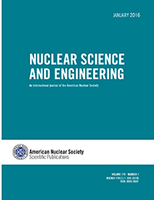
NUCLEAR SCIENCE AND ENGINEERING
Your Gateway to Cutting-Edge Nuclear ResearchNUCLEAR SCIENCE AND ENGINEERING, published by Taylor & Francis Inc, is a leading journal in the field of nuclear energy and engineering, providing a vital platform for disseminating cutting-edge research and advancements from both academia and industry. With an ISSN of 0029-5639 and an E-ISSN of 1943-748X, the journal boasts a notable impact factor and is categorized in the Q2 quartile for 2023, reflecting its influence and quality in the field. Covering a comprehensive scope from the inception of nuclear technology in 1969 to contemporary advancements forecasted for 2024, it ranks #38 out of 77 in the Scopus Energy – Nuclear Energy and Engineering category, placing it in the 51st percentile. Although the journal is not open access, it remains essential for researchers, professionals, and students seeking to stay abreast of the latest developments and innovations in nuclear science. Located in the heart of Philadelphia, NUCLEAR SCIENCE AND ENGINEERING contributes significantly to the advancement of nuclear engineering knowledge and practice, making it a crucial resource for anyone involved in this dynamic field.